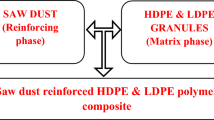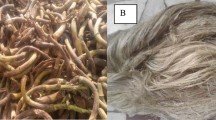Abstract
Selection of a material for their end use in engineering applications depends on the properties of materials. In this paper, physical and mechanical properties of teak sawdust-polypropylene composite are evaluated and most suitable composition for outdoor applications have been determined by using TOPSIS technique of optimization. Virgin and recycled polypropylene are mixed with teak sawdust to fabricate the composite with and without maleated polypropylene (MAPP) using compression molding method. TOPSIS technique of optimization involves prioritizing the performance indicators. Important properties such as tensile strength, flexural strength, impact strength, hardness, melt flow index, water absorption and thickness of swell are selected for the study. The composition 50% recycled polypropylene, 45% wood sawdust and 5% MAPP by weight is found to be most suitable for outdoor applications.












Similar content being viewed by others
References
Thakur V K and Thakur M K 2014 Processing and characterization of natural cellulose fibers thermoset polymer composites. J. Carbohydr. Polym. 109: 102–117
Azwa Z N, Yousif B F, Manalo A C and Karunasena W 2013 A review on the degradability of polymeric composites based on natural fibres. J. Mat. Des. 47: 424–442
Ashori A and Nourbakhsh A 2009 Characteristics of wood–fiber plastic composites made of recycled materials. J. Waste Manag. 29: 1291–1295
Nafaji S K, Tajvidi M and Hamidina E 2007 Effect of temperature, plastic type and virginity on the water uptake of sawdust/plastic composites. J. Holz Roh Werkst. 65: 377–382.
Adhikary K B, Pang S and Staiger M P 2008 Dimensional stability and mechanical behaviour of wood–plastic composites based on recycled and virgin high-density polyethylene (HDPE). Composites: Part B. 39: 807–815
Bledzki A K, Faruk O and Huque M 2002 Physico-mechanical studies of wood fiber reinforced composites. J. Polym. Plast. Technol. Eng. 41(3): 435–451
La Mantia FP and Morreale M 2011 Green composites: A brief review J. Composite Part A: Appl. Sci. Manuf. 42: 579–588
Adhikary K B, Shusheng P and Staiger M P 2008 Long term moisture absorption and thickness swelling recycled thermoplastics reinforced with pinus radita sawdust recycled and virgin high density polyethylene. J. Chem. Eng. 142: 190–198
Tamrakar S, Roberto A. Lopez-Anido 2011 Water absorption of wood polypropylene composite sheet piles and its influence on mechanical properties. J. Construction and Building Materials 25: 3977–3988
[10]Shanian A and Savadogo O 2006 TOPSIS multiple-criteria decision support analysis for material selection of metallic bipolar plates for polymer electrolyte fuel cell. J. Power Sources. 159: 1095–1104
Rao R V and Patel B K 2010 A subjective and objective integrated multiple attribute decision making method for material selection. J. Mat. and Des. 37(10): 4738–4747
American Standard test method 2014 D 638-14 standard test method for tensile properties of plastics. ASTM International, West Conshohocken, USA
American Standard test method 2003 D790 – 03 standard test methods for flexural properties of unreinforced and reinforced plastics and electrical insulating materials. ASTM International, West Conshohocken, USA
American Standard test method 2003 D 256-10 standard test methods for determining the izod pendulum impact resistance of plastics. ASTM International, West Conshohocken, USA
American Standard test method 2003 D 2240-15 Standard test method for rubber property durometer hardness. ASTM International, West Conshohocken, USA
American Standard test method 2003 D 1238-10. Standard test method for melt flow rates of thermoplastics by extrusion plastometer. ASTM International, West Conshohocken, USA
American Standard test method 1998 D 570-98 Standard test method for water absorption of plastics. ASTM International, West Conshohocken, USA
Byun H S and Lee K H 2005 A decision support system for the selection of a rapid prototyping process using the modified TOPSIS method’ J. Adv. Manuf. Technol. 26: 1338–1347
Srikrishna S, Reenivasulu R and Vani S 2014 A new car selection in the market using TOPSIS Technique. IJEGS 177–181. ISSN 2091-2730
Fatih Dogan 2014 Morphology and Thermo Mechanical Properties of Wood/Polypropylene Composites. Intech Open access: 415–428
Laly A Pothan 2009 Natural Fibre Reinforced Polymer Composites: From Macro to Nanoscale Archives contemporaines ISBN 2914610998, 9782914610995
Author information
Authors and Affiliations
Corresponding author
Rights and permissions
About this article
Cite this article
Yadav, A.K., Srivastava, R. Selection of teak sawdust polypropylene composite’s composition for outdoor applications using TOPSIS analysis. Sādhanā 45, 231 (2020). https://doi.org/10.1007/s12046-020-01435-w
Received:
Revised:
Accepted:
Published:
DOI: https://doi.org/10.1007/s12046-020-01435-w




